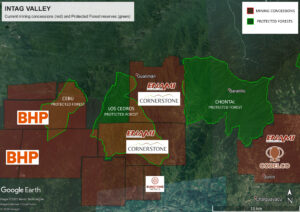Sunstone Metals agreement to acquire El Palmar, a copper-gold project in northern Ecuador is an ecological nightmare fraught with risks. El Palmar abuts the Los Cedros Biological Reserve, a scientific observational and research site, with a case for protection soon to be heard at the Constitutional Court in Ecuador.

Los Cedros Biological Reserve in north-western Ecuador has one of the most biologically diverse habitats in the world, with over 200 species with high extinction risk, five of which are regarded as critically endangered by the Ecuadorian government. The reserve covers more than 4,800 hectares (nearly 12,000 acres) of primary cloud forest, and safeguards the headwaters for four rivers, the Rio Manduriacu, the Rio Verde, the Rio Los Cedros, and the Rio Magdalena Chico.
“The challenge of establishing a mine in this area cannot be underestimated. The hills are precipitous, and the main road through the region is barely wide enough to take a single vehicle with a sheer drop on one side. The challenges for transporting mineral ore are enormous. Add to this new laws by the Ecuadorian Ministry of Mines which prevent mining companies from establishing tailings dams upstream. In an area like this, there is nowhere tailings can be safely stored,” says Rebekah Hayden, a member of the Rainforest Action Group.
The elevations at the Sunstone concession climb from 800m to 1400m in less than a kilometre.
“The area forms the watershed for a number of important rivers, including the Rio Manduriacu which runs at the base of the El Palmar concession. The steepness of the site means contamination of the waterways are inevitable,” Rebekah Hayden says.
“Previous owners of El Palmar halted plans for exploration once they realised how difficult the terrain is for such little gain. Sunstone’s purchase may well lure in investors whose money will end up at Bramaderos,” says Anthony Amis, a researcher for the Rainforest Action Group.
Sunstone Metals are just the latest mining company to circle the reserve. The Ecuadorian state mining company ENAMI is jointly exploring the reserve with Chile giant Codelco and Cornerstone Capital Resources. BHP also has claims directly adjacent to, and slightly overlapping the reserve.
The scientific importance of this area was emphasised by a letter-writing campaign organised by the US Centre for Biological Diversity in July to the CEOs of the various mining companies, which was signed by 1200 scientists including Jane Goodall and EO Wilson.
“The local community is strongly opposed to mining, with an ongoing legal campaign against ENAMI and Cornerstone Capital Resources about to go to the Constitutional Court. A new mine in the area could not be established without a protracted legal campaign and active community resistance,” says Rebekah Hayden.
“After several years of fighting the mining companies in courts, in May the Constitutional Court of Ecuador announced it will take on the case of Los Cedros, in a move which could prevent other Australian companies like BHP, Newcrest, Hancock Prospecting, Fortescue Metals and Solgold from mining in Protected Forests,” says Rebekah Hayden.
Los Cedros Reserve was established in 1988 with the help of a grant from the Australian Government’s Development Assistance Bureau and the support of Australian not-for-profit organisation the Rainforest Information Centre.
Full media Release here.
